Mawlana Shaykh Mohammed Adil – Khawajagan Ziyarah Tour 15-24/9-2021
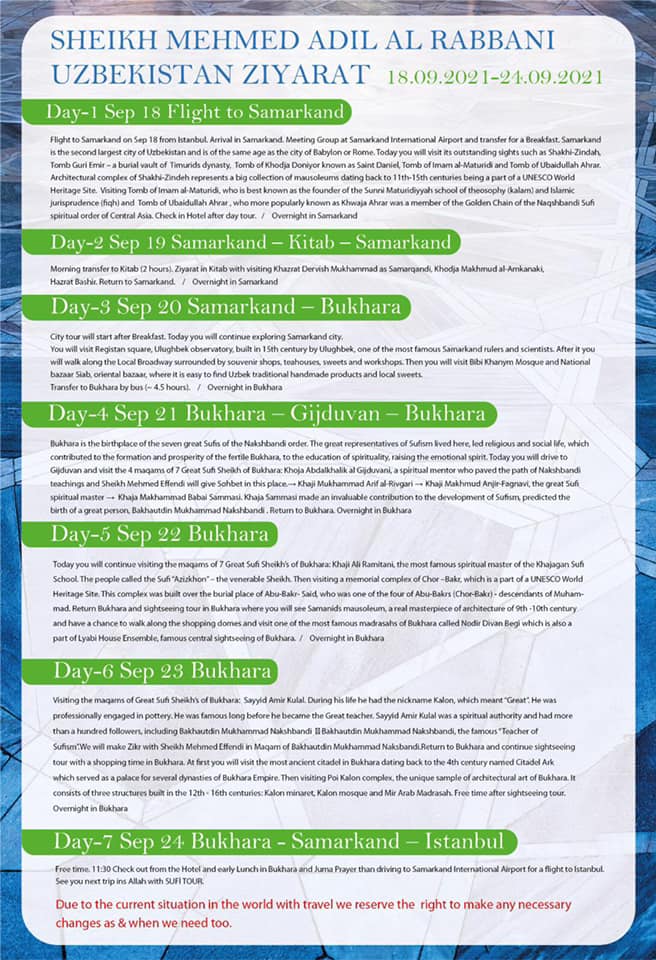

Pilgrimage is a way to pray to Great Allah through past saints, to calm the mind and spirit, to understand the truth of holiness, to walk the path of solitude and purification. In Central Asia, this is called Pilgrimage, which means visiting sacred sites. At a new stage of development of our country, large-scale creative work is being carried out to restore and develop our national traditions and values, honor the memory of our ancestors, beautify sacred shrines and ziyarah places, increase their prestige in the Muslim world. Purpose of continuing this work, the Resolution of the Cabinet of Ministers of the Republic of Uzbekistan dated February 15, 2018 number – 120 “On the effective organization of work on the beautification of sacred sites, shrines, mosques and cemeteries.
Khwājagān
Khwājagān (shortened/singular forms: Khwaja, Khaja(h), Khawaja or khuwaja) is a Persian title for “the Masters”. Khwajagan, as the plural for “Khwāja”, is often used to refer to a network of Sufis in Central Asia from the 10th to the 16th century who are often incorporated into later Naqshbandi hierarchies, as well as other Sufi groups, such as the Yasaviyya. In Firdowsi’s Shahnama the word is used many times for some rulers and heroes of ancient Iran as well. The special zikr of the Khwajagan is called ‘Khatm Khajagan’.
Some prominent Khwajagan
Prominent Central Asian Khwajagan included:
- Khwaja Ubaidullah Ahrar
- Yusuf Hamdani
- Khwaja Ahmad Yasavi
- Abdul Khaliq Gujduvani
- Baha-ud-Din Naqshband Bukhari
- Maulana Nur ad-Din Abd ar-Rahman Jami
- Nur Chashme Khwajagan Sayyid Mir Jan
See also THE MASTERS OF WISDOM OF CENTRAL ASIA:
The sacred places of the XIV-XVI centuries in Bukhara, Samarkand and Kashkadarya regions play a special role in the development of tourism in Uzbekistan. Many of the shrines in these areas belong to Great Sheikhs listed in “Golden Chain”.

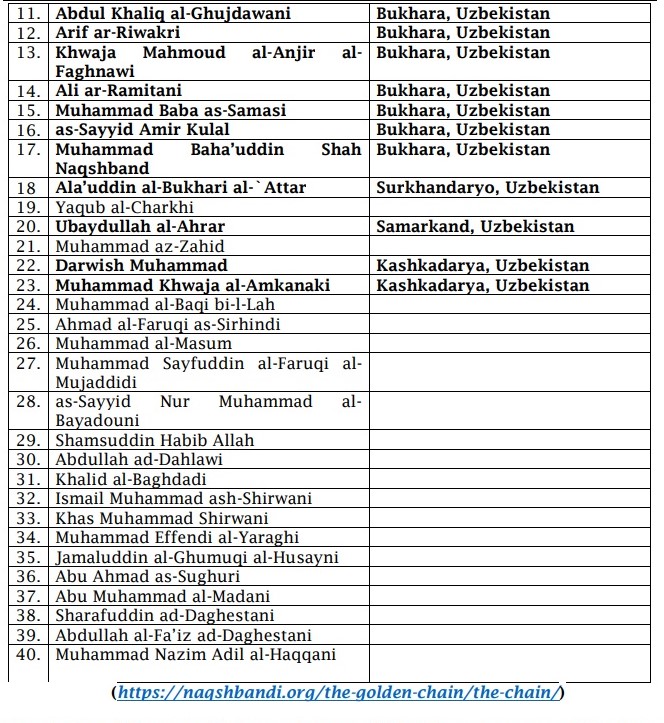
Maqam van Shaykh Ahmad Yasavi 15-09-21
Ahmad Yasawī; 1093–1166) was a Turkic[1] poet and Sufi, an early mystic who exerted a powerful influence on the development of Sufi orders throughout the Turkic-speaking world
Yasawi became the head murshid of the Naqshbandi order when Hassan-i Andākī died in 1160. He then turned this position to Abdul Khaliq Ghajadwani under Hamadani’s advice and moved to Turkistan City in order to spread Islam in Turkestan
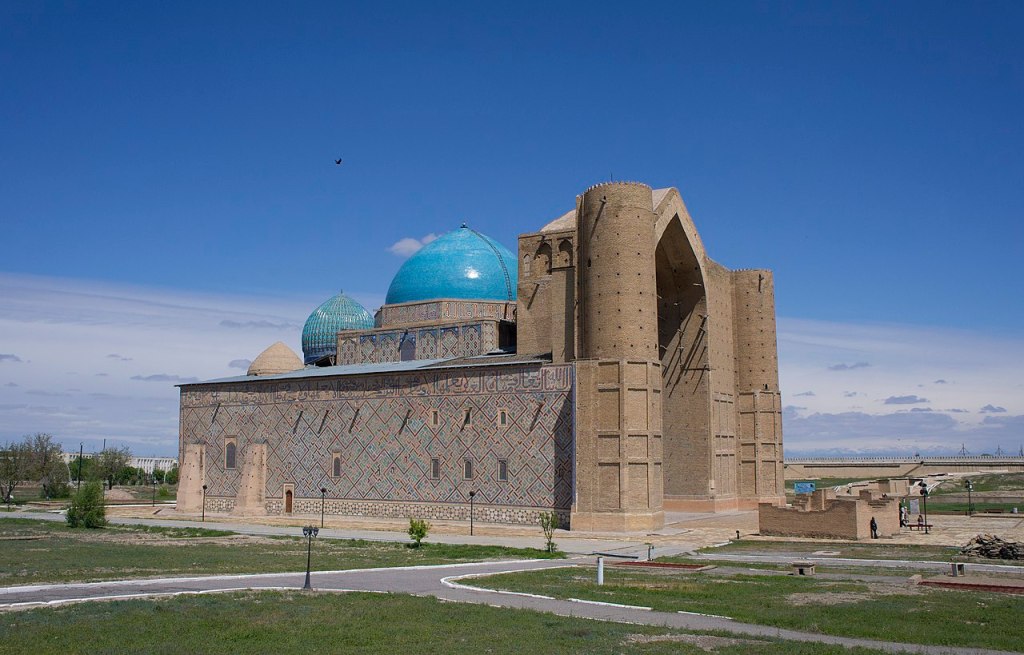
Influence
Ahmad Yasawi made considerable efforts to spread Islam throughout Central Asia and had numerous students in the region. Yasawi’s poems created a new genre of religious folk poetry in Central Asian Turkic literature and influenced many religious poets in the following countries.[9] Yasawi turned the city of Iasy into the major centre of learning for the Kazakh Steppe, then retired to a life of contemplation at the age of 63. He dug himself an underground cell where he spent the rest of his life.
Turkish scholar Hasan Basri Çantay noted: “It was a Seljuk king who brought Rumi, the great Sufi poet, to Konya; and it was in Seljuq times that Ahmed Yasawi, another great Sufi, lived and taught. The influence of those two remarkable teachers has continued to the present.”[10] Yasawi is also mentioned by Edward Campbell (writing as Ernest Scott)[11] as a member of the Khwajagan. Yasawi also influenced Turkish poet Yahya Kemal Beyatlı, he said: “Who is this Ahmad Yasawi? If you study him, you will find our nationality in Him.”[12]

Legacy
- The Mausoleum of Khoja Ahmed Yasawi[13] was later built on the site of his grave by Timur in Turkistan City. The Yesevi order he founded continued to be influential for several centuries afterwards, with the Yesevi Sayyid Ata Sheikhs holding a prominent position at the court of Bukhara into the 19th century.[14] There is the greatest influence of shamanistic elements in the Yasawiyya compared to other Sufi orders.[15]
- Yesevi authored the Book of Wisdom (Turkic: ديوان حكمت, Dīvān-i Ḥikmet), a collection of poems, in Turkic.[3] The book was published in 1905 and 1895 in Kazan.[4]
- The Naqshbandi Idries Shah mentions Yasawi’s lineage in The Book of the Book.[16]
- The first Kazakh-Turkish university, Ahmet Yesevi University,[17] was named in his honor.
Legends about Ahmed Yasawi
Date palm
Legend has it that a religious mystic, Arystan-Bab, was the teacher and spiritual mentor of Khoja Ahmad Yasawi. It was Arystan-Bab who transmitted the amanat, which was contained in a pip of date palm. According to a legend, Arystan-Bab was an associate of the Prophet Muhammad. One day, Prophet Muhammad and his companions sat and ate dates. One of the fruits fell out of the dish, and the Prophet heard the revelation: “This date is for the Muslim Ahmad, who will be born 400 years later than You.” The Prophet asked his companions who would pass this persimmon to its future owner. No one volunteered. The Prophet repeated his question, and then Arystan-Bab answered: “If you beg Allah to give me 400 years of life, then I will give the date.”[18]
Timur’s dream
It is believed that one night Timur saw Ahmad Yasawi in his dream, where Yasawi predicted glad tidings of the forthcoming conquest of Bukhara. Taking this as a sign, Timur went on a campaign that would indeed be successful. After his victory, he decided to visit the grave of Yasawi and ordered to build there a majestic mausoleum.[19]
Maqam van Shaykh Ahmad Yasavi 15-09-21
Ahmad Yasawī; 1093–1166) was a Turkic[1] poet and Sufi, an early mystic who exerted a powerful influence on the development of Sufi orders throughout the Turkic-speaking world
Yasawi became the head murshid of the Naqshbandi order when Hassan-i Andākī died in 1160. He then turned this position to Abdul Khaliq Ghajadwani under Hamadani’s advice and moved to Turkistan City in order to spread Islam in Turkestan
Influence
Ahmad Yasawi made considerable efforts to spread Islam throughout Central Asia and had numerous students in the region. Yasawi’s poems created a new genre of religious folk poetry in Central Asian Turkic literature and influenced many religious poets in the following countries.[9] Yasawi turned the city of Iasy into the major centre of learning for the Kazakh Steppe, then retired to a life of contemplation at the age of 63. He dug himself an underground cell where he spent the rest of his life.
Turkish scholar Hasan Basri Çantay noted: “It was a Seljuk king who brought Rumi, the great Sufi poet, to Konya; and it was in Seljuq times that Ahmed Yasawi, another great Sufi, lived and taught. The influence of those two remarkable teachers has continued to the present.”[10] Yasawi is also mentioned by Edward Campbell (writing as Ernest Scott)[11] as a member of the Khwajagan. Yasawi also influenced Turkish poet Yahya Kemal Beyatlı, he said: “Who is this Ahmad Yasawi? If you study him, you will find our nationality in Him.”[12]
Legacy
- The Mausoleum of Khoja Ahmed Yasawi[13] was later built on the site of his grave by Timur in Turkistan City. The Yesevi order he founded continued to be influential for several centuries afterwards, with the Yesevi Sayyid Ata Sheikhs holding a prominent position at the court of Bukhara into the 19th century.[14] There is the greatest influence of shamanistic elements in the Yasawiyya compared to other Sufi orders.[15]
- Yesevi authored the Book of Wisdom (Turkic: ديوان حكمت, Dīvān-i Ḥikmet), a collection of poems, in Turkic.[3] The book was published in 1905 and 1895 in Kazan.[4]
- The Naqshbandi Idries Shah mentions Yasawi’s lineage in The Book of the Book.[16]
- The first Kazakh-Turkish university, Ahmet Yesevi University,[17] was named in his honor.
Legends about Ahmed Yasawi
Date palm
Legend has it that a religious mystic, Arystan-Bab, was the teacher and spiritual mentor of Khoja Ahmad Yasawi. It was Arystan-Bab who transmitted the amanat, which was contained in a pip of date palm. According to a legend, Arystan-Bab was an associate of the Prophet Muhammad. One day, Prophet Muhammad and his companions sat and ate dates. One of the fruits fell out of the dish, and the Prophet heard the revelation: “This date is for the Muslim Ahmad, who will be born 400 years later than You.” The Prophet asked his companions who would pass this persimmon to its future owner. No one volunteered. The Prophet repeated his question, and then Arystan-Bab answered: “If you beg Allah to give me 400 years of life, then I will give the date.”[18]
Timur’s dream
It is believed that one night Timur saw Ahmad Yasawi in his dream, where Yasawi predicted glad tidings of the forthcoming conquest of Bukhara. Taking this as a sign, Timur went on a campaign that would indeed be successful. After his victory, he decided to visit the grave of Yasawi and ordered to build there a majestic mausoleum.[19]

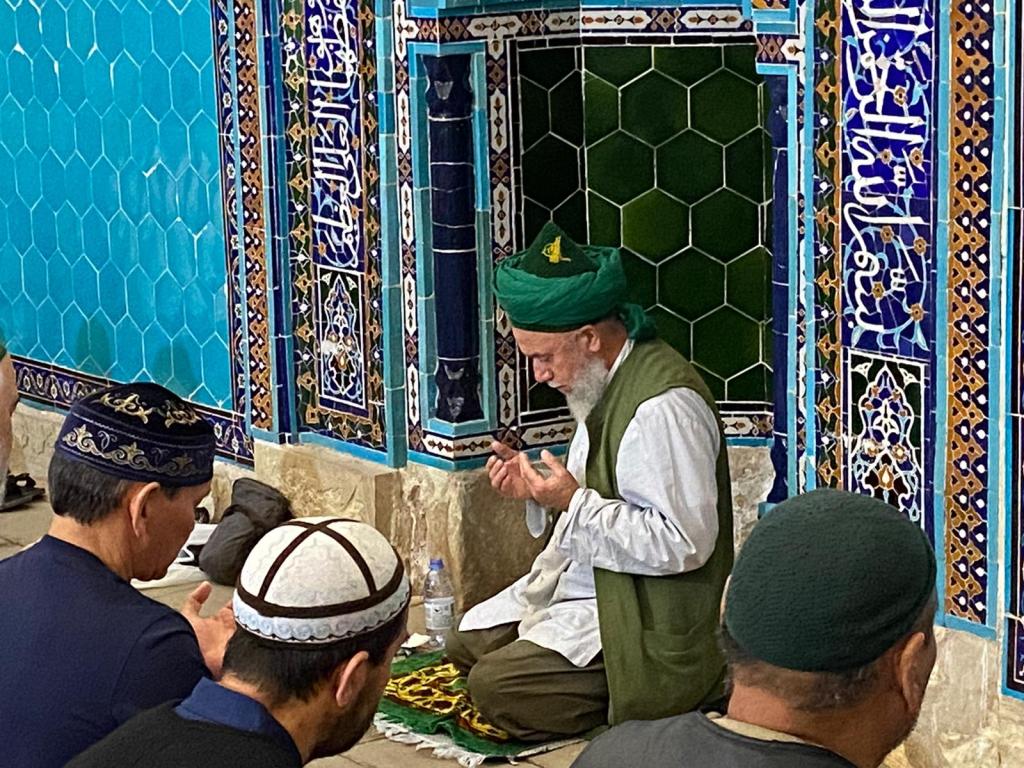

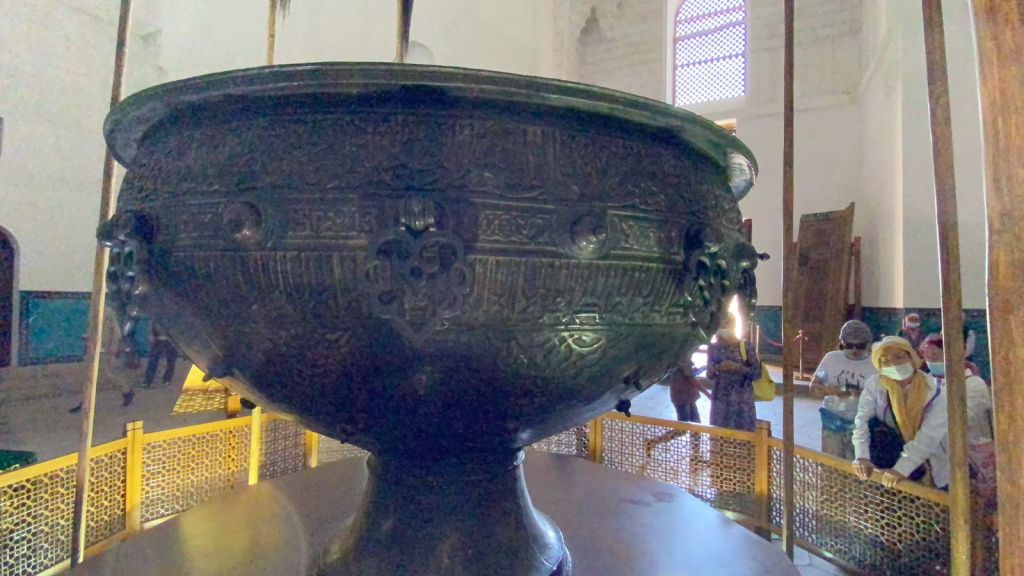

Juma met Mawlana Shaykh Mohammed Adil q in Tashkent, Oezbekistan voor de Centraal-Azië Tour.


Legend about Uzbekistan
By the ancient legend, the Lord allotted lands of the created world to all nations. Being kind and friendly, Uzbek made the way for everyone in the crowd: “Please, pass. Markhamat.”
When, finally, it was his turn, the Lord said to him: “My son, you came too late. I have already finished the allotment of lands. Where were you before?” Uzbek bowed to the Heavenly Father and, laying his hand on his chest, said,” Oh, our Creator! You taught me to be always merciful and to love neighbors. And I, the servant of God, gave the way to everyone who wished to go forward and therefore I am the last who appeared before your eyes”.
Face of God brightened up and pure smile lit up his face. He said: “My son, Uzbek! You turned out a truly generous person with pure soul. And now I am going to give you land that I left for myself and which is like a paradise.”
So the Creator of Heaven and Earth gave Uzbek the land which was between two large rivers, flowing from the mountains. The name of this land is Uzbekistan.
Mawlana Shaykh Mohammed Adil – Khawajagan Ziyarah TourSeptember -2021

Sept 18 2021 – Shah-i-Zinda Complex
Sept 19- 2021 Samarkand – Kitab – Samarkand
Hazrat Daud Cave near Samarkand
Sept 20 -2021 Samarkand – Bukhara
Sep 21 – 2021 Bukhara – Gishduwan – Bukhara
Announcement About Khatm Al Khwajagan (21.09.2021) From Maqam of Sayyidina Abdul Khaliq Al Ghujduwani, Uzbekistan


